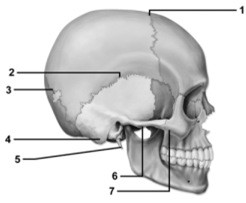The study of surface anatomy attempts to relate, among other things,
A) the size and strength of the muscles near or at the surface of the body.
B) structure to the age of the individual.
C) physical and physiological conditions in an individual.
D) the structure and location of the skeletal and muscular systems.
E) None of the answers are correct.
D) the structure and location of the skeletal and muscular systems.
You might also like to view...
Iodine accumulation in thyroid cells involves symport with
A) sodium. B) potassium. C) chloride. D) hydrogen.
If you examined an x-ray of a wrist and noticed the epiphyseal lines were closed, what could you conclude about this individual?
A. The person has not yet reached puberty.
B. The person is post-pubescent.
C. The blood supply has been cut off from the epiphyses.
D. Intramembranous ossification closed the epiphyseal lines.
 This figure shows a lateral view of the skull. Which number indicates the lambdoid suture?
This figure shows a lateral view of the skull. Which number indicates the lambdoid suture?
A. 1 B. 2 C. 3 D. 4 E. The lambdoid suture is not shown on this figure.
What part of the brain is the "boss" of the autonomic nervous system (ANS)?
A) thalamus B) pons C) hypothalamus D) basal nuclei